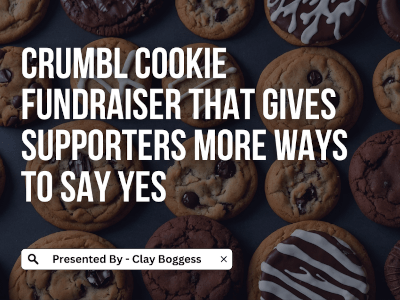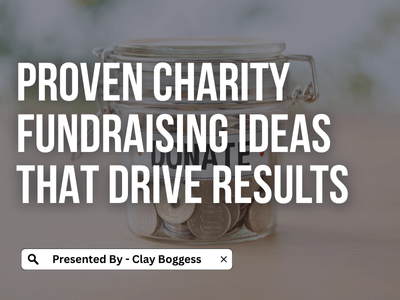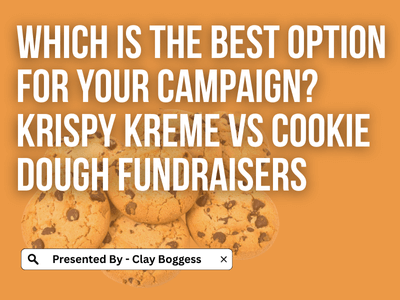
Blog Summary: In fundraising, organizations often face the critical decision of choosing between product and event fundraisers. This comprehensive guide thoroughly explores both methods, outlining their unique advantages and challenges.
Fundraising is critical for many organizations, especially nonprofits, schools, and community groups. Two popular methods stand out when raising funds: product and event fundraising. Each has unique advantages and challenges, and choosing between them is a significant decision for any organization. This blog will explore how to choose between these two fundraising strategies by examining their features, benefits, and considerations.
Understanding Product Fundraising
What Is Product Fundraising?
Product fundraising involves selling items to raise money for a cause. Organizations often partner with vendors who provide products that can be sold at a profit. Common products include:
Gourmet Popcorn
Gourmet popcorn is a popular fundraising item that offers a variety of flavors, from classic butter and cheese to more unique options like caramel, chocolate drizzle, or spicy seasonings. This product appeals to a wide audience due to its versatility and the fact that it can be packaged attractively for gifting or personal enjoyment. Organizations often partner with vendors specializing in gourmet snacks to provide high-quality options.
Discount Cards
Discount cards offer holders discounts at local businesses or services. They are typically sold at a fixed price; the funds raised go directly to the organization. Discount cards often include deals for restaurants, retail stores, and entertainment venues, providing value to buyers who can save money while supporting a good cause. The appeal lies in the long-term savings potential for cardholders.
Cookie Dough
Cookie dough fundraising involves selling tubs of pre-made cookie dough that supporters can bake at home. This product is particularly popular among schools and youth organizations because it offers a fun and delicious way to raise funds.
The dough can come in various flavors, making it appealing to families looking for convenient baking options. Organizations often partner with established brands to ensure quality and variety.
Candles
Candles are another popular fundraising product, often sold in various scents and styles. Many organizations partner with candle makers who provide high-quality, hand-poured options. Candles appeal to supporters looking for home décor or gifts, and they can be marketed as eco-friendly or made from natural ingredients. This product is especially popular when people look for thoughtful gifts during the holiday season.
Gift Wrap
ift wrap fundraising typically involves selling rolls of decorative wrapping paper, gift bags, and accessories like ribbons and tags. This option is especially appealing when many people prepare gifts for family and friends during the holiday season. Organizations can offer a variety of designs and themes to cater to different tastes. Selling gift wraps raises funds and provides practical items that supporters will use during festive occasions.
The appeal of product fundraising lies in the tangible items that supporters receive in exchange for their donations. This method can be particularly effective for schools, sports teams, and community organizations looking to engage supporters while providing them with something of value.
Advantages of Product Fundraising
- Tangible Rewards: Supporters appreciate receiving something in return for their contributions, enhancing donor satisfaction and loyalty.
- Wide Variety: There are countless products to choose from, allowing organizations to select items that resonate with their audience. Seasonal products can also align with holidays or special events.
- Engagement Opportunities: Selling products can involve volunteers, fostering community spirit and teamwork. This collaborative effort can strengthen relationships within the organization.
- Lower Overhead Costs: If partnered with the right vendors, many product fundraisers can be organized with minimal upfront costs, making them accessible for organizations with limited budgets.
Challenges of Product Fundraising
While product fundraising has its benefits, it also comes with challenges:
- Market Saturation: Many organizations may sell similar products, making it harder to stand out.
- Inventory Management: Organizations must manage stock levels effectively to avoid over-ordering or running out of popular items.
- Sales Pressure: Some supporters may feel pressured to buy products, which could lead to dissatisfaction if they don’t want or need the items.
Understanding Event Fundraising
What Is Event Fundraising?
Event fundraising involves organizing an event where participants contribute financially to attend or participate. Examples include the following:
Charity Runs or Walks
Charity runs, or walks, are organized events where participants pay an entry fee to compete in a race or walk a designated distance, often for a specific cause. These events can range from fun runs to more competitive races and typically include opportunities for participants to raise additional funds through sponsorships. They promote physical activity and community engagement while raising awareness and funds for the chosen charity.
Auctions
Auctions are fundraising events in which items or experiences are sold to the highest bidder. They can be live auctions conducted by an auctioneer or silent auctions, where bids are written on sheets. Items can range from donated goods, services, and experiences to unique items like signed memorabilia. Auctions create excitement and competition among bidders, often resulting in higher-than-expected fundraising totals.
Galas
Galas are formal fundraising events that often include dinner, entertainment, and speeches highlighting the organization’s mission. Attendees usually pay for tickets or tables, and additional funds can be raised through auctions or donation drives during the event. Galas provide an elegant atmosphere for networking and fostering relationships among supporters while showcasing the organization’s work and impact.
Bake Sales
Bake sales involve selling homemade baked goods, such as cookies, cakes, and pastries. They are typically organized by schools, community groups, or nonprofits. Participants donate their baked items, then sold at a designated location. This grassroots fundraising method is simple to organize and appeals to local communities, creating a sense of camaraderie while raising funds for a cause.
Concerts
Concerts are live music events that raise money for a specific cause or organization. They can feature local artists or well-known performers who donate their time and talent. Ticket sales, merchandise, and sponsorships contribute to the fundraising efforts. Concerts raise money and create an enjoyable experience that brings the community together in support of a shared mission.
Event fundraising creates face-to-face interaction and community-building opportunities while raising funds for a cause.
Advantages of Event Fundraising
- Community Engagement: Events foster community and allow for personal connections between donors and the cause. This interaction can lead to increased loyalty and support in the future.
- Potential for Larger Donations: Events can attract more significant donations from attendees who may be willing to give more when they see the impact firsthand. High-profile guests or speakers can also encourage larger contributions.
- Media Attention: Well-organized events can attract local media coverage, increasing the organization's visibility and generating future support and partnerships.
- Networking Opportunities: Events provide a platform for networking among attendees, sponsors, and other stakeholders, leading to new partnerships or collaborations in the future.
Challenges of Event Fundraising
Despite its benefits, event fundraising has its own set of challenges:
- High Upfront Costs: Organizing an event may require a significant upfront investment in venue rental, catering, permits, and marketing materials.
- Time Intensive: Planning an event requires considerable time and effort from volunteers and staff.
- Weather Dependency: Outdoor events are subject to weather conditions that could impact attendance and revenue.
Key Considerations When Choosing Between Product and Event Fundraising
Choosing between product fundraising and event fundraising requires careful consideration of several factors:
Audience Engagement
- Product Fundraising: Appeals to supporters who prefer convenience; they can purchase items without attending an event. This method is ideal for busy individuals who may not have time to attend events but still want to support their cause.
- Event Fundraising: Engages those who enjoy social interactions and community involvement; it creates a memorable experience tied to the cause. Events often attract individuals looking for meaningful ways to spend their time while contributing to a good cause.
Time Commitment
- Product Fundraising generally requires less time to organize than events but may require ongoing sales efforts. Once set up, product fundraisers can run for weeks or months with minimal oversight.
- Event Fundraising: Involves significant planning, coordination, and execution efforts but can yield high rewards for engagement and donations. The time invested often correlates with the scale of the event planned.
Financial Goals
- Product Fundraising: Often has lower upfront costs but may have lower overall revenue potential unless scaled effectively. Organizations must ensure they choose high-demand products that will sell well.
- Event Fundraising: Can generate substantial funds through ticket sales, sponsorships, and auctions but requires more resources upfront. The potential return on investment is usually higher if executed well.
Flexibility
- Product Fundraising: Can be done year-round with various products; adaptable based on seasonal interests. Organizations can pivot quickly based on trends or community preferences.
- Event Fundraising: Typically tied to specific dates; flexibility is limited once the event is scheduled. However, successful events can be repeated annually or biannually if they resonate well with attendees.
Hybrid Approaches
In some cases, organizations may benefit from combining both strategies. A hybrid approach could involve selling products during an event or launching a crowdfunding campaign leading up to an event. This strategy allows organizations to maximize their outreach and fundraising potential by leveraging the strengths of both methods.
For example:
- Event Merchandise Sales: Selling branded merchandise at an event raises additional funds and promotes your organization.
- Pre-event Product Sales: Offering products leading up to an event encourages early engagement and builds excitement among supporters.
- Post-event Follow-ups: After an event, organizations can follow up with attendees, offering exclusive product deals as a thank-you for their participation.
Frequently Asked Questions (FAQs)
1. What are some examples of successful product fundraisers?
Successful product fundraisers often include gourmet food items like popcorn or cookie dough, branded merchandise like t-shirts or mugs, or discount cards that offer savings at local businesses. Schools frequently use these methods due to their appeal among parents and students alike.
2. How do I promote my fundraising event effectively?
Effective promotion involves using social media platforms (Facebook, Instagram), email newsletters targeting your supporter base, flyers distributed in local businesses or schools, and local media outlets covering community events. Creating engaging content highlighting the fundraiser's mission will attract more participants.
3. What are the typical costs associated with organizing an event fundraiser?
Costs can vary widely depending on the type of event. Still, they may include venue rental (which could range from $500-$5,000), catering (averaging $20-$50 per person), marketing materials (printing flyers or digital ads), permits (if required), entertainment (like live music), and insurance fees if necessary. It's essential to budget carefully to ensure that expenses are within anticipated revenue.
4. How do I determine which fundraising method is best for my organization?
Consider your audience's preferences through surveys or polls about what type of fundraising they prefer—products vs events—your organization's resources (time and budget), financial goals (how much you aim to raise), and how much engagement you want from your supporters. Consider past experiences; if one method has yielded better results, it might be worth exploring again.
5. Can I use both methods in my fundraising strategy?
Absolutely! Many organizations successfully combine product sales and events to maximize their fundraising efforts. A hybrid approach allows you to reach different audience segments effectively while providing multiple avenues for support.
Choosing between product and event fundraising is not a one-size-fits-all decision; it depends on various factors, including organizational goals, audience preferences, time commitment, financial considerations, and available resources.
By understanding each method's unique advantages and challenges and considering a hybrid approach when appropriate, organizations can develop effective fundraising strategies that resonate with their supporters while achieving their financial objectives.
Author Bio
Clay Boggess has been designing fundraising programs for schools and various nonprofit organizations throughout the US since 1999. He's helped administrators, teachers, and outside support entities such as PTAs and PTOs raise millions of dollars. Clay is an owner and partner at Big Fundraising Ideas.



